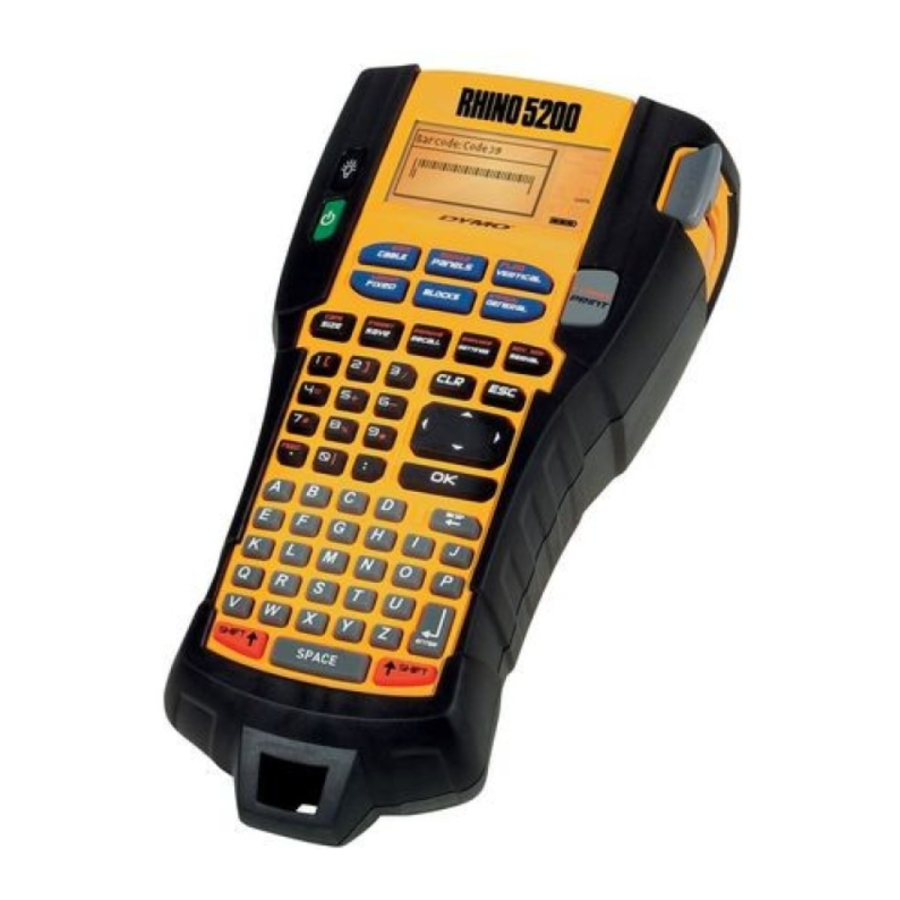
Dymo Rhino 5200 - Industrial Handheld Label Printer
- Quick start manual (68 pages) ,
- User manual (24 pages) ,
- Quick reference manual (16 pages)
Advertisement
- 1 About Your New Printer
- 2 Getting Started
- 3 Getting to Know Your Printer
- 4 Working with Label Files
- 5 Formatting a Label
- 6 Creating Industrial Labels
- 7 Using Barcodes
- 8 Using the Text Library
- 9 Creating a Series of Labels
- 10 Printing Options
- 11 Using Printer Memory
- 12 Cleaning Your Printer
- 13 Symbols
- 14 Troubleshooting
- 15 Videos
- 16 Documents / Resources

About Your New Printer
With your new RHINO label printer, you can create a wide variety of high-quality, self-adhesive labels. You can choose to print your labels in many different sizes and styles. The printer uses RHINO Industrial label cartridges in widths of 6 mm, 9 mm, 12 mm, or 19 mm. RHINO label cartridges are also available in a wide range of materials, such as flexible nylon, permanent polyester, vinyl, nonadhesive tag, and heat shrink tubes.
Visit www.dymo.com for information on the full line of labels and accessories for your printer.
Warranty Registration
Visit www.dymo.com/register to register your label printer online. During the registration process, you will need the serial number, which is located inside the battery compartment.
Getting Started
Follow the instructions in this section to start using your printer for the first time.
Connecting the Power
The printer can be powered with batteries or AC power. A rechargeable Lithium-ion battery pack and AC power adapter are included with some models. Visit www.dymo.com for information on obtaining an optional rechargeable battery pack.

To save power, the printer will automatically turn off after five minutes of inactivity.
Inserting the Batteries
The printer can operate using six AA alkaline batteries.
To insert the batteries
- Press the thumb latch on the back of the printer to remove the battery compartment cover. See Figure 2.
![]()
- Insert the batteries into the battery compartment. See Figure 2.
- Replace the battery compartment cover.

Connecting the Optional Power Adapter
The printer uses a 110V-240V power adapter. Connecting the power adapter with the battery pack inserted recharges the battery pack.
Use only the DYMO power adapter included with the printer.
To connect the power adapter
- Plug the power adapter into the power connector on the top of the printer. See Figure 3.
![]()
- Plug the other end of the power adapter into a power outlet.
Inserting the Optional Battery Pack
The hard case kit includes a rechargeable, Lithium- ion battery pack for portable use when not connected to the power adapter.
To insert the battery pack
- Press the thumb latch on the back of the printer to remove the battery compartment cover. See Figure 4.
![]()
- Insert the battery pack into the battery compartment. See Figure 4.
- Replace the battery compartment cover.

Recharging the Battery Pack
The battery pack automatically recharges while the printer is connected to a power source through the power adapter. Charging the battery pack for the first time will take approximately eight hours; recharging the battery pack will take approximately two hours.
Inserting and Removing the Label Cartridge
Your printer comes with a starter label cartridge. Visit www.dymo.com for information about purchasing additional label cartridges.
 Cutter blade is extremely sharp. While replacing the label cartridge, keep fingers and other body parts away from cutter blade and do not press the cutter button.
Cutter blade is extremely sharp. While replacing the label cartridge, keep fingers and other body parts away from cutter blade and do not press the cutter button.
To insert the label cartridge
- Gently lift the label cartridge door on the back of the printer.
- Make sure the label and ribbon are taut across the mouth of the cartridge and that the label passes between the label guides. If necessary, turn the ribbon rewind spool clockwise to tighten the ribbon.
- Insert the cartridge with the label and ribbon positioned between the label guides.
![Dymo - Rhino 5200 - Inserting the label cartridge Inserting the label cartridge]()
- Press firmly on the cartridge until the cartridge snaps into place.
To avoid tape jams, make sure both sides of the label cartridge snap into place. - Close the label cartridge door.
To remove the label cartridge
- Gently lift the label cartridge door on the back of the printer.
- Gently remove the label cartridge.
- Insert a new label cartridge as described above.
- Reset the label width as described in Setting the Label Width.
Setting the Label Width
Each time you insert a label cartridge into the printer, you are prompted to set the label width so the printer knows what size label you are currently using. Some of the features you use to design labels depend on the width of the label.
However, to create a label for a label width different than what is currently in the printer, you can set the label width at any time from the Settings menu.
To set the label width
- Press
![]() .
.
The Settings menu appears on the display. - Select Label width and press
![]() .
. - Select the width of the label currently inserted in the printer.
- Press
![]() and then select Done (OK).
and then select Done (OK).
Selecting a Language
The first time you turn on the power, you are prompted to select your desired language. By default, the language is set to English.
Several language-related features on the printer are determined by the language setting, such as special characters, menu text, and so on. You can change the language selection at any time from the Settings menu.
To select a language
- Press
![]() .
. - Select Language and press
![]() .
. - Select the language.
- Press
![]() and then select Done (OK).
and then select Done (OK).
Selecting Units of Measure
The first time you turn on the power, you are prompted to select your desired units of measure. You can choose to work in inches or millimeters. You can change the units of measure at any time from the Settings menu.
To select the units of measure
- Press
![]() .
. - Select Units and press
![]() .
. - Select inch or mm.
- Press
![]() and then select Done (OK).
and then select Done (OK).
Getting to Know Your Printer
Become familiar with the location of the feature and function keys on your printer. See Figure 1. The following sections describe each feature in detail.
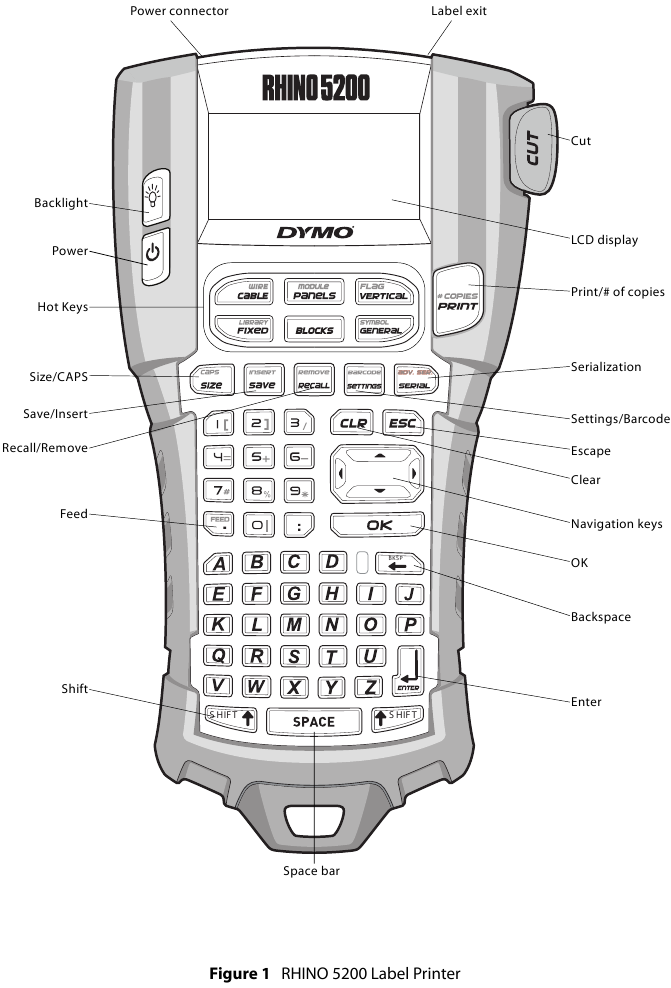
Power
The  button turns the power on and off. If no keys are pressed after five minutes, the power is turned off automatically.
button turns the power on and off. If no keys are pressed after five minutes, the power is turned off automatically.
When the printer is turned off, the current label file and its settings are remembered for the next time the printer is turned on. If the batteries and power adapter are disconnected at the same time, some of the settings are remembered; however, the current label file is lost and you will need to reset the label width when you reconnect the power and turn on the printer.
LCD Display
The LCD display includes a caption bar across the top showing the current label type, and feature indicators on the right side showing which features are currently selected. See Figure 6.
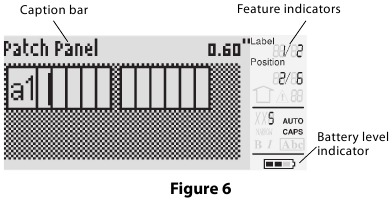
When the text you have entered will not fit on the label as currently defined, the portion of the text that will not fit is shaded. If you attempt to print the label containing text that will not fit, the excess text will not be printed.
Using the Backlight
In low light conditions, you can turn on the backlight to make it easier to see the display. To save power, the back light will turn off automatically after 15 seconds of inactivity. Pressing any key will turn the backlight back on again. The backlight key acts as a toggle to turn the light on and off.
To toggle backlighting on and off
- Press
![]() .
.
Adjusting the Display Contrast
In addition to backlighting, you can adjust the display contrast to help in different lighting conditions.
To adjust the display contrast
- Press
![]() .
. - Select LCD contrast and press
![]() .
. - Use the arrow keys to select a value between 0 (lighter) and 8 (darker). The contrast changes as you select the different settings.
- Press
![]() , and then select Done (OK).
, and then select Done (OK).
Caption Bar
The Caption bar at the top of the display shows the current label type and for some label types, additional information about the label, such as size or barcode type.
CAPS Mode
The  key toggles capitalization on and off.
key toggles capitalization on and off.
When CAPS mode is turned on, the CAPS indicator is shown on the display and all letters that you enter are capitalized. The default setting is CAPS mode on. When CAPS mode is off, all letters entered appear in lowercase.
To toggle CAPS on and off
- Press
![]() +
+ ![]() .
.
Shift Key
The  keys are used to select the function or symbol printed above a key. For example, when you press
keys are used to select the function or symbol printed above a key. For example, when you press  , the number 9 appears in the display; however, if you press
, the number 9 appears in the display; however, if you press  and then
and then  , an asterisk (*) appears in the display.
, an asterisk (*) appears in the display.
Escape Key
The  key returns you to the previous menu from within any menu without making a selection.
key returns you to the previous menu from within any menu without making a selection.
Navigation Keys
The navigation keys operate as follows:
| Key | Function |
 | Moves one character to the left in the display Returns to the previous menu (can also use  ) ) |
SHIFT | Moves one cell to the left in a multi-cell label Moves one label to the left in the display |
 | Moves one character to the right in the display Moves to the next menu level (can also use  ) ) |
SHIFT | Moves one cell to the right in a multi-cell label Moves one label to the right in the display |
 | Moves up in a list of items |
 | Moves down in a list of items |
| OK | Selects a menu item |
Backspace Key
The  key removes the character to the left of the cursor.
key removes the character to the left of the cursor.
Clear Key
The  key clears all current text settings and format, returning the display to the General label type.
key clears all current text settings and format, returning the display to the General label type.
Cutter Button
The Cut button cuts the label. When printing multiple labels, the printer pauses after printing each label so that you can cut the label. You can turn this feature off, so that multiple labels will print continuously. See Pausing Between Labels.
Hot Keys
A number of Hot Keys are available for creating specific types of labels, adding barcodes, inserting symbols, and using the text from the library. These Hot Keys are described in detail later in this User Guide.
Working with Label Files
The printer creates and stores labels as label files. A label file can contain one or more labels. When you create a new label, you also create a new label file. You can then insert additional labels, remove labels, and store a group of labels as a label file in memory.
Creating a Label File
The printer remembers the last label that you were working on when the power was turned off. You need to clear that label text and formatting before you create a new label.
To create a new label file
- If necessary, press
![]() to clear the previous label and formatting from the display.
to clear the previous label and formatting from the display. - Type some text using the keypad.
- Format the text using Text size or Text styles.
See Formatting a Label. - Save the label to memory.
See Saving a Label File.
Adding Labels to a Label File
You can add additional labels to an existing label file.
To add a label to a file
- Press
![]() +
+![]() .
. - Select To the right to add a label to the right of the cursor position or To the left to add a label to the left of the cursor position.
- Press
![]() . A new blank label is inserted in the display to the left or right of the current label.
. A new blank label is inserted in the display to the left or right of the current label.
You can move from label to label using the arrow keys.
Removing Labels from a File
You can remove one or more labels from a label file.
To remove a label
- Press
![]() +
+ ![]() .
. - Select one of the following:
- All to remove all of the labels in the file.
- Current to remove the label at the current cursor position.
- Range and then select the range of labels to remove.
- Press
![]() .
.
The selected labels are removed from the display.
Printing a Label File
When you print a label file, you choose whether to print all of the labels, the current label, or a range of labels in the file.
To print labels
- Press
![]() . If your label file contains more than one label, the print menu is displayed.
. If your label file contains more than one label, the print menu is displayed. - Select one of the following:
- All to print all of the labels in the file.
- Current to print the label at the current cursor position.
- Range and then select the range of labels to print.
- Press
![]() . The selected labels are printed.
. The selected labels are printed. - Press the CUT button and remove the labels.
Formatting a Label
You can choose from a number of formatting options to enhance the appearance of your labels.
Changing the Text Size
You can print the text on your label in several sizes: extra-extra-small, extra-small, small, medium, large, extra-large, and BIG (all capital letters). The text size selected applies to all the text on all the labels in a label file.
The text size available for you to use depends on the width set for the label and the type of label you are creating.
You can also select Auto as the text size. When Auto is selected, the best text size is automatically determined for the height and width of the label you are creating. BIG font is not used when Auto text size is selected.
To set the text size
- Press
![]() . Each time you press
. Each time you press ![]() , the next available text size is highlighted on the Size feature indicator on the display.
, the next available text size is highlighted on the Size feature indicator on the display.
Changing the Text Style
You can print the text on your label in several styles: bold, italic, underlined, and boxed. And, you can choose normal width or narrow width. The text style applies to all the text on all the labels in the label file, including most symbols.
To set the text style
- Press
![]() .
. - Select Text styles and press
![]() .
. - Select a style and press
![]() .
. - Select On or Off to enable or disable the selected style.
- Press
![]() and then select Done (OK).
and then select Done (OK).
To set the text width
- Press
![]() .
. - Select Text styles and press
![]() .
. - Select Font and press
![]() .
. - Select Narrow or Normal.
- Press
![]() and then select Done (OK).
and then select Done (OK).
To insert an underlined 6 or 9 character
- Press and hold
![]() or
or ![]() until 6 or 9 appears in the display.
until 6 or 9 appears in the display.
Creating Multi-Line Labels
You can create multi-line labels depending upon the width of the label, as follows:
| Label Width | 6 mm | 9 mm | 12 mm | 19 mm |
| # Lines | 1 | 3 | 3 | 5 |
The display only shows two lines of text. Use the arrow keys to scroll through more than two lines.
To create a multi-line label
- Type the text for the first line, and press
![]() .
. - Type the text for the next line.
- Repeat these steps for each additional line.
Using International Characters
The printer supports the extended Latin character set using RACE technology. Similar to using a mobile phone keypad, holding down a letter key will scroll through variations of that letter.
For example, if you hold down the letter a, you will see a à á â ã ä å and so on through all the variations available. The order in which the character variations appear depends on the language you selected to use.

Creating Industrial Labels
You can quickly create labels for special industrial applications, such as cable or wire wrap, flag, patch panel, electrical panel, terminal block, 110-block, or module. You can also create a fixed length label. Hot Keys are available for each of the label types. The current label type is displayed in the Caption bar. By default, the label type is General with no special formatting, text centered, and the length automatically determined by the amount of text. The Hot Keys always take you to the indicated label type. For example, if you choose Flag and later want a General label, press the General key to remove the Flag settings and return to General label type.
Creating Cable and Wire Labels
You can create several types of labels that wrap around a cable or wire: Cable, Wire, and Flag labels.
Creating Cable Labels
A Cable label is placed around the width of a wire or cable. You can enter up to five lines of text and the text is repeated as many times as possible depending on the size of the text and the length of the label.
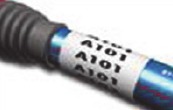
To create a cable label
- Press
![]() .
. - Enter the diameter of the cable and press
![]() .
.
To create multiple labels quickly, see Creating a Series of Labels.
Creating Wire Labels
A Wire label is placed horizontally along the length of a wire or cable. The label text is repeated as many times as possible depending on the size of the text and the width of the label.
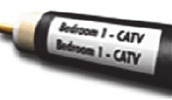
To create a wire label
- Press
![]() +
+ ![]() .
.
The label length is automatically determined by the amount of text entered.
To create multiple labels quickly, see Creating a Series of Labels.
Creating Flag Labels
Flag labels wrap around a wire or cable leaving the text part of the label extending out from the cable. The text on Flag labels is automatically printed on both ends of the label, leaving a blank space in the middle that wraps around the cable. When the label is applied to the cable, both ends of the label are applied back to back leaving a tail or flag. The result is a label that can be read from both sides.
To create a flag label
- Press
![]() +
+ ![]() .
. - Select Small, Medium, Large, or XLarge for the wrap around portion and press
![]() .
. - Enter or select the length for the flag portion of the label and press
![]() .
.
Select AUTO to have the length automatically set to fit the text.
To create multiple labels quickly, see Creating a Series of Labels.
Creating Fixed Length Labels
Normally, the length of the label is determined by the length of the text entered. However, you may want to make a label for a specific purpose that is a fixed length regardless of the length of the text. The factory default fixed length is 25 mm. Any change you make to the fixed length setting remains in effect until you change it.
To set the label length
- Press
![]() .
. - Enter or select the length of the label and press
![]() .
.
Any text that does not fit within the fixed length appears shaded in the display and will be cut off when the label is printed.
Creating Panel Labels
You can create two types of panel labels: Patch Panel and Electrical Panel labels.
Creating Patch Panel Labels
A Patch Panel label allows you to label a row of ports on a patch panel. You select the distance between ports, enter the text, and print. The result is a long label with multiple, evenly spaced text for each port.
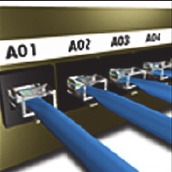
To create a patch panel label
- Press
![]() .
. - Select Patch panel and press
![]() .
. - Enter or select the distance between each port and press
![]() .
.
The default distance is 12 mm. - Enter or select the number of ports and press
![]() .
.
Each port is separated by a solid black line on the display. - Enter the text for each port in the label.
Use the left or right arrow key to move from port to port.
To create data for the ports automatically, see Creating a Series of Labels.
To print separator lines between the ports, see Printing Separator Lines Between Cells.
Creating Electrical Panel Labels
An Electrical Panel label allows you to label a row of breakers on an electrical panel. You select the breaker size and number of breakers, enter the text, and print. The result is a long label with text for each breaker.
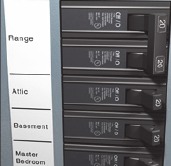
To create an electrical panel label
- Press
![]() .
. - Select Electrical panel and press
![]() .
. - Enter or select the breaker length and press
![]() .
.
Select the length that applies to the smallest size breaker in the panel. You can then use breaker multipliers to increase the size of any individual breakers that are larger. The default breaker size is 25.4 mm. - Enter or select the number of breakers and press
![]() .
. - Select the breaker multiplier for each breaker and press
![]() .
.
Each breaker is separated by a solid black line on the display. - Enter the text for each breaker in the label.
Use the up or down arrow key to move from breaker to breaker.
To adjust the breaker multipliers after a label has been created, see Using Breaker Multipliers.
To create data for the breakers automatically, see Creating a Series of Labels.
To print separator lines between the breakers, see Printing Separator Lines Between Cells.
Using Breaker Multipliers
Breaker multipliers allow you to adjust the size of individual breakers within an Electrical Panel label.
To adjust the size of an individual breaker
- Create an Electrical Panel label as described in Creating Electrical Panel Labels.
- Press
![]() .
. - Select Current label config. and press
![]() .
. - Select Breaker multipliers and press
![]() .
. - Use the up and down arrow keys to select the breaker number to adjust and press
![]() .
. - Select the multiplier for that breaker.
- Press
![]() and then Done (OK) to return to the label.
and then Done (OK) to return to the label.
Printing Empty Breakers
By default, empty breakers at the end of an Electrical Panel label are not printed. You can choose whether or not to print empty breakers at the end of a label.
To print empty breakers
- Press
![]() .
. - Select Print empty breakers and press
![]() .
. - Select On and press
![]() .
. - Select Done (OK) to return to the label. Any empty breakers at the end of an Electrical Panel label will now be printed.
Creating Block Labels
You can create two types of block labels: Terminal Block and 110-Block labels.
Creating Terminal Block Labels
A Terminal Block label is very similar to a Patch Panel label; however, the text is printed vertically for each block.
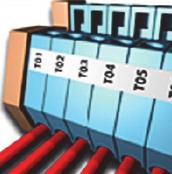
To create a terminal block label
- Press
![]() .
. - Select Terminal block and press
![]() .
. - Enter or select the number of blocks and press
![]() .
. - Enter or select the block width and press
![]() .
.
The default block width is 17.5 mm.
Each block is separated by a solid black line on the display. - Enter the text for each terminal.
Use the up or down arrow key to move from terminal to terminal.
To create data for the terminal blocks automatically, see Creating a Series of Labels.
To print separator lines between the ports, see Printing Separator Lines Between Cells.
Creating 110-Block Labels
You can only print a 110-Block label on 9 mm, 12 mm, or 19 mm wide labels.
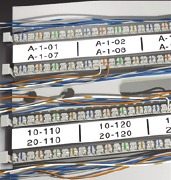
To create a 110-block label
- Press
![]() .
. - Select 110-block and press
![]() .
. - Select the block type and press
![]() .
. - Select Single row or Dual row and press
![]() .
.
Each block is separated by a solid black line on the display. - Enter the text for each block.
Use the left or right arrow key to move from block to block. Use the up or down arrow key to move from row to row.
To create data for the blocks automatically, see Creating a Series of Labels.
To print separator lines between the blocks, see Printing Separator Lines Between Cells.
Creating Module Labels
A Module label allows you to label a row of fuses of varying widths. You set the width of a fuse and the number of fuses, enter the text for each fuse, and print. You can use fuse multipliers to adjust the width of individual modules as necessary.
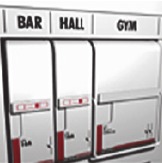
To create a module label
- Press
![]() +
+ ![]() .
. - Enter or select the fuse length and press
![]() .
.
Select the length that applies to the smallest size fuse in the module. You can then use fuse multipliers to increase the size of any individual modules that are larger. The default fuse length is 25.4 mm. - Enter or select the number of modules and press
![]() .
. - Enter the fuse multiplier for each module and press
![]() .
.
Each fuse is separated by a solid black line on the display. - Enter the text for each module.
Use the left or right arrow key to move from module to module.
To adjust the fuse multipliers after a label has been created, see Using Fuse Multipliers.
To create the data for the modules automatically, see Creating a Series of Labels.
Using Fuse Multipliers
Fuse multipliers allow you to adjust the size of individual fuse modules within a module type label.
To adjust the size of an individual module
- Create a Module label as described in Creating Module Labels.
- Press
![]() .
. - Select Current label config. and press
![]() .
. - Select Fuse multipliers and press
![]() .
. - Use the up and down arrow keys to select the module number to adjust and press
![]() .
. - Select the multiplier for that module.
- Press
![]() and then Done (OK) to return to the label.
and then Done (OK) to return to the label.
Printing Empty Modules
By default, empty modules at the end of a Module label are not printed. You can choose whether or not to print empty modules at the end of a label.
To print empty modules
- Press
![]() .
. - Select Print empty modules and press
![]() .
. - Select On and press
![]() .
. - Select Done (OK) to return to the label.
Any empty modules at the end of a Module label will now be printed.
Creating Vertical Labels
You can choose to print labels with the text running vertically. Labels with multiple lines of text will print as multiple columns of text.
To create a vertical label
- Press
![]() .
. - Enter or select a length for the label and press
![]() .
.
Select AUTO to have the length of the label automatically set to fit the text.
Changing the Label Type
Once you create a label using one label type, you can easily change the label type without losing your data.
If the data from one label type will not fit in the new label type, the text that will not fit is shaded in the display.
Example: When you change from a multi-cell label, such as a Patch Panel, to a single cell label, such as General or Flag, each cell becomes a new label. All blank cells are deleted.

To change the label type
- Press the hot key for the new label type.
- Make any necessary adjustments to the settings for the label type.
Changing the Label Settings
Once you create a specific label, you can change the settings without starting all over again.
To change the label settings
- Press
![]() .
. - Select Current label config. and press
![]() .
.
The settings for the particular label type are displayed. - Make the necessary changes.
- Press
![]() and then select Done (OK).
and then select Done (OK).
Printing Separator Lines Between Cells
For multiple cell labels, such as Patch Panel, Electrical Panel, Terminal Block, 110-Block, and Module, you can choose to print a separator line between each of the cells.
To print separator lines between cells
- Create the type of multiple cell label you want.
- Press
![]() .
. - Select Current label config. and press
![]() .
. - Select Separator lines and press
![]() .
. - Select On.
- Press
![]() and then select Done (OK). A line is printed between each cell.
and then select Done (OK). A line is printed between each cell.
Using Barcodes
The printer can generate Code 39 and Code 128 barcodes. You can add a barcode to the following label types:
General
Wire
Flag
Fixed
Patch Panel
Module
You can only print a barcode on 19 mm wide labels. You can choose whether or not to print the humanreadable text, and you can serialize barcodes.
The barcode prints horizontally along the label. You can choose to print the human-readable text in small print either underneath or above the barcode. Optionally, you can add text before and after the barcode.
Adding a Barcode
The barcode text appears on the label in the display just like any other text. However, if the cursor is positioned within the barcode text, Barcode and the type of barcode are displayed in the Caption bar.
To add a barcode
- Press
![]() +
+ ![]() .
. - Select Barcode type and press
![]() .
. - Select the barcode type, and press
![]() .
. - Enter the text for the barcode within the barcode on the display.
- Press
![]() and then select Done (OK).
and then select Done (OK).
Editing a Barcode
You can edit the text for an existing barcode.
To edit a barcode
- Move the cursor anywhere within the barcode text.
Barcode and the type of barcode are displayed in the Caption bar. - Enter any character. A message appears asking if you would like to edit the barcode.
- Press
![]() .
. - Edit the barcode text and press
![]() .
.
Deleting a Barcode
A barcode is entered on the label as one character.
To delete a barcode
- Place the cursor at the end of the barcode text on the display.
- Press
![]() .
.
Positioning Human-Readable Barcode Text
You can choose to place the human-readable text above or below the barcode. By default, the label prints with the human-readable text below the barcode.
To change the barcode text location
- Press
![]() +
+ ![]() .
. - Select HR position and press
![]() .
. - Select Above barcode or Below barcode.
- Press
![]() and then select Done (OK).
and then select Done (OK).
Hiding Barcode Text
You can choose to hide the human-readable text for the barcode.
To hide barcode text
- Press
![]() +
+ ![]() .
. - Select Barcode HR and press
![]() .
. - Select Off.
- Press
![]() and then select Done (OK).
and then select Done (OK).
Adding Symbols
Your printer includes a set of default symbols to use on your labels. The symbols are separated into several categories:
Electrical
Voice/Data
Warning
Punctuation
Brackets
Arrows
Numbers
Currency
Some of the more popular symbols can be accessed from the number keys using  plus the number. For example, pressing
plus the number. For example, pressing  + 1 inserts an open bracket ([).
+ 1 inserts an open bracket ([).
Inserting Symbols
Symbols added to a label can be formatted or deleted just like any other character you enter. To insert a symbol
- Press
![]() +
+ ![]() .
. - Select a category of symbols or select All to view all symbols, and then press
![]() .
. - Use the arrow keys to select the symbol you want.
- Press
![]() to insert the symbol on the label.
to insert the symbol on the label.
Using the Text Library
Your printer includes a text library, called My Library. You can add custom text to the library and then use the library to quickly add text to your labels.
Adding My Library Text
Text entries appear in the library list in the order in which they were added to the library.
To add custom text
- Press
![]() +
+ ![]() .
. - Select Add new text and press
![]() .
. - Enter the text you want and press
![]() .
.
The text is added to My Library.
Inserting Library Text
Library text added to a label is the same as text entered from thekeypad. Library text can be edited, formatted, or deleted.
To add text to a label
- Press
![]() +
+ ![]() .
. - Select the text to add to your label and press
![]() .
.
The text is added to your label.
Deleting My Library Text
You can delete custom text from My Library.
To delete My Library text
- Press
![]() +
+ ![]() .
. - Select the text to delete and press
![]() .
.
A confirmation message appears. - Press
![]() to delete the text.
to delete the text.
Creating a Series of Labels
You can automatically generate labels by creating a series. You create a starting pattern, and then set the increment and count for the series.
You can serialize any number or letter by selecting the position to be incremented, such as the number 2 in 123 or the letter B in ABC. For example, when the 2 is selected in 123 and the increment #=3, the resulting labels would print as 123, 153, and 183.
Letters can be incremented from A to Z and a to z, and numbers from 1 to 9. When the letter Z or the number 9 is reached during serialization, a letter or number is added to increase the increment. For example, Az increments to Aaa, AZ increments to BA, and A9 increments to A10.
Three methods of serialization are available: simple, simultaneous, and advanced.
Using Simple Serialization
Simple serialization creates a series of labels by incrementing one alphanumeric character in the pattern. For example, 101, 102, 103, 104, and so on.
To use simple serialization
- Enter the text for your label.
- Press
![]() . A box appears around the character where the cursor was positioned.
. A box appears around the character where the cursor was positioned. - Use the arrow keys to move the cursor to the character you want to increment and press
![]() .
. - Select the amount you want to increment each label and press
![]() .
.
You can choose to increment in steps up to 10. - Select the number of labels you want to create and press
![]() .
.
You can choose to create up to 99 labels.
A new label is added in the display for each label in the series.

 +
+  to print multiple copies of the same serialized label. See Printing Multiple Copies.
to print multiple copies of the same serialized label. See Printing Multiple Copies.
Using Simultaneous Serialization
Simultaneous serialization creates a series of labels by incrementing two different alphanumeric characters at the same time. For example, A-101, B- 102, C-103, and so on.
To use simultaneous serialization
- Enter the text for your label.
- Press
![]() +
+ ![]() .
. - Select Simultaneous and press
![]() .
.
A box appears around the character where the cursor was positioned. - Select the first character position you want to increment and press
![]() .
. - Select the second character position you want to increment and press
![]() .
. - Select the amount you want to increment these characters on each label and press
![]() .
.
You can choose to increment in steps up to 10. - Select the number of labels you want to create and press
![]() .
.
You can choose to create up to 99 labels.
A new label is added in the display for each label in the series.
Using Advanced Serialization
Advanced serialization creates a series of labels by allowing you to select two sequences in the pattern and increment them consecutively.
For example, A-101, A-102, A-103, B-101, B-102, B- 103, C-101, C-102, C-103, and so on.
To use advanced serialization
- Enter the text for your label.
- Press
![]() +
+ ![]() .
. - Select Advanced and press
![]() .
.
A box appears around the character where the cursor was positioned. - Select the first character position you want to increment and press
![]() .
. - Select the amount you want to increment this character position and press
![]() .
.
You can choose to increment in steps up to 10. - Select the number of times to increment this character position and press
![]() .
. - Repeat Steps 4 through 6 for the second character position you want to increment. You can choose to create up to 99 labels.
A new label is added in the display for each label in the series.
Printing Options
You can choose to print multiple copies of the same label, collate the copies, pause to cut between labels, advance the label, and adjust the print contrast.
Printing Multiple Copies
You can print up to 99 copies of the same label at one time.
To print multiple copies
- Press
![]() +
+ ![]() .
. - Press the
![]() arrow to increase the number of copies to print (maximum is 99). The default is 2 copies.
arrow to increase the number of copies to print (maximum is 99). The default is 2 copies. - Press the
![]() arrow to decrease the number of copies.
arrow to decrease the number of copies. - Press
![]() or
or ![]() to begin printing.
to begin printing.

Collating Multiple Copies
When printing multiple copies of a label file containing more than one label, all the copies of a label are printed before the next label starts printing. You can choose to have the label file print collated, so each complete copy of the file prints before the second copy starts. The following example shows three copies of a label file containing three labels printed normally and collated.
Normal
A101 A101 A101 A102 A102 A102 A103 A103 A103
Collated
A101 A102 A103 A101 A102 A103 A101 A102 A103
To collate multiple copies
- Press
![]() .
. - Select Collate copies and press
![]() .
. - Select On.
- Press
![]() and then select Done (OK).
and then select Done (OK).
Pausing Between Labels
By default the printer pauses after printing each label so you can cut the label. You can turn this feature off to have the labels print continuously.
To set the printer to print continuously
- Press
![]() .
. - Select Pause to cut btw labels and press
![]() .
. - Select Off.
- Press
![]() and then select Done (OK).
and then select Done (OK).
Advancing the Label
The default leader space for all labels is approximately 10 mm. To add additional blank space to the beginning or end of your label, you can feed the label in 10 mm increments.
To advance the label
- Press
![]() +
+ ![]() .
. - Press
![]() to advance the label.
to advance the label.
Adjusting Print Contrast
Depending on the label material you choose, you may need to lighten or darken the print on the label.
To adjust the print contrast
- Press
![]() .
. - Select Print contrast and press
![]() .
. - Use the arrow keys to adjust the print contrast.
- Press
![]() and then select Done (OK).
and then select Done (OK). - Repeat as necessary until you are satisfied with the print quality.
Using Printer Memory
The printer has a powerful memory feature that can store label files for later recall. The number of label files that can be stored is dependent on the size of the label files.
Saving a Label File
When you save a label file, all the label text and formatting are saved. A label file name can be up to 20 alphanumeric characters in length.
To save a label file
- Create the labels in your label file.
- Press
![]() .
. - Select New and press
![]() .
. - Enter a name for your label file and press
![]() .
. - Press
![]() to start a new label.
to start a new label.
Recalling a Label File from Memory
Once a label is saved to memory, you can recall the label to print or edit. Recalling a label replaces the current label.
To recall a label from memory
- Press
![]() .
.
The memory locations are displayed. - Select the memory location that contains the label you want and press
![]() .
.
A message appears confirming that you want to clear the current label text and formatting. - Press
![]() .
.
Deleting a Label File from Memory
When you no longer need a stored label file, you can delete the file from memory.
To delete a label from memory
- Press
![]() .
.
The saved label files are displayed. - Select the label file you want to delete.
- Press
![]() +
+ ![]() , and then press
, and then press ![]() to clear the memory location.
to clear the memory location.
Cleaning Your Printer
Your printer is designed to give you long and trouble-free service, while requiring very little maintenance.
Clean your printer from time to time to keep it working properly.
![]() Cutter blade is extremely sharp.
Cutter blade is extremely sharp.
Keep fingers and other body parts away from cutter blade and do not press the cutter button.
To clean the print head
- Remove the label cartridge.
- Remove the cleaning tool from inside the label cartridge door.
- Gently wipe the padded side of the tool across the print head. See Figure 7.
![Dymo - Rhino 5200 - Cleaning Cleaning]()
Symbols
The following tables show the default symbols by category.
Electrical
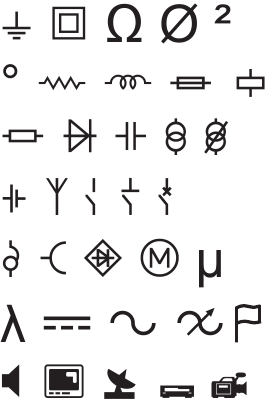
Voice/Data

Warning

Punctuation
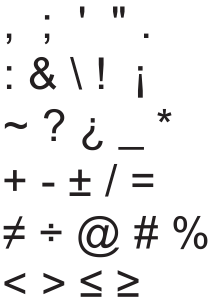
Brackets

Arrows

Numbers

Currency

Troubleshooting
Review the following possible solutions if you encounter a problem while using your printer.
| Problem/Error Message | Solution |
| Battery Low Battery Empty  |
|
| Poor Print Quality |
|
| Label Jam Motor is stalled due to label jam. |
|
| Uneven or slanted printing The cartridge is not positioned correctly. |
|
| Cannot close the label cartridge lid The cartridge is not inserted correctly. | Make sure nothing is blocking the cartridge cover and that the label cartridge is inserted properly. See Inserting and Removing the Label Cartridge. |
| Unable to return to the previous menu |
|
| Nothing shows on the display |
|
| Insert label cartridge No cartridge is present. | Open the cartridge compartment and insert a label cartridge. See Inserting and Removing the Label Cartridge. |
| Display text is too light to read |
|
| Too many lines Too many lines for this label width. |
|
| Barcode not allowed Barcodes can only be printed on 19 mm wide labels. |
|
| Print error... The label is jammed. |
|
| No response when pressing keys One of the keys may be jammed. |
|
| How do I remove the backing from the label? | RHINO labels have an easy-peel split back.
|
If you still need assistance, visit the DYMO Web site at www.dymo.com.
Documentation Feedback
We are constantly working to produce the highest quality documentation for our products. We welcome your feedback.
Send us your comments or suggestions about our user guides. Please include the following information with your feedback:
- Product name, version number, and page number
- Brief description of content (instructions that are inaccurate or unclear, areas where more detail is needed, and so on)
We also welcome your suggestions about additional topics you would like to see covered in the documentation.
Send email messages to: documentation@dymo.com
Please keep in mind that this email address is only for documentation feedback. If you have a technical question, please contact Customer Support.
Safety Precautions for Lithium-Ion Rechargeable Battery Pack
Inaccurate handling of a Lithium-ion rechargeable battery may cause leakage, heat, smoke, an explosion, or fire. This could cause deterioration of performance or failure. This may also damage the protection device installed in the battery pack. This could damage equipment or injure users. Thoroughly follow the instructions below.
While Charging
- When charging the battery, use dedicated chargers and follow the specified conditions.
- Do not connect directly to an electric outlet or cigarette lighter charger.
- Do not use or store battery close to fire or inside the car where temperature may be over 60°C.
- Stop charging the battery if charging is not completed within the specified time.
- Thoroughly read this user guide before charging the battery.
- Do not charge in a place that generates static electricity.
- Battery can only be charged within 0°C~45°C temperature range.
When Discharging the Battery
- Use the battery only in the specified equipment.
- Do not use or store battery close to fire or inside the car where temperature may be over 60°C.
- Do not charge in a place that generates static electricity.
- Battery can only be used within -20°C~60°C temperature range.

VideosDymo Rhino 5200 & Tape Bundle Unboxing Video
Documents / ResourcesDownload manual
Here you can download full pdf version of manual, it may contain additional safety instructions, warranty information, FCC rules, etc.
Download Dymo Rhino 5200 - Industrial Handheld Label Printer
Advertisement
Thank you! Your question has been received!
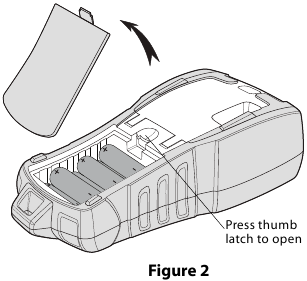
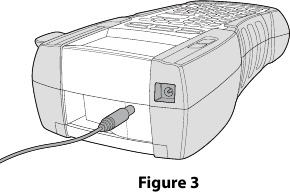


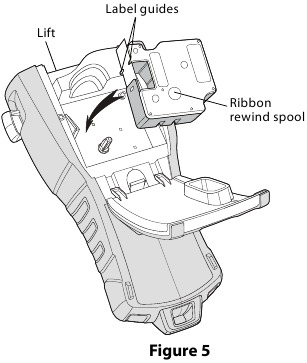
 .
. .
. .
. .
. or
or  .
. .
. .
. .
. .
. .
. .
. . A box appears around the character where the cursor was positioned.
. A box appears around the character where the cursor was positioned. .
. to start a new label.
to start a new label. .
.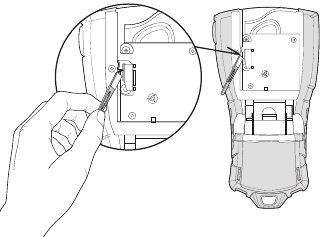
 to return to the previous menu.
to return to the previous menu. to return to the display and clear all settings.
to return to the display and clear all settings.






















Need Assistance?
Do you have a question about the Rhino 5200 that isn't answered in the manual? Leave your question here.